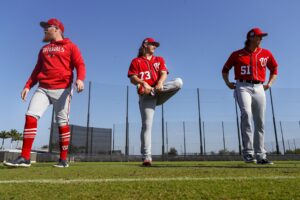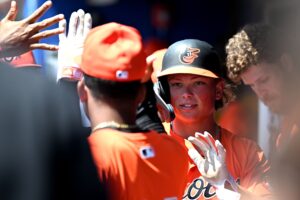The 1880s dawned with one major league in play, yet would end with two. The American Association formed in 1882. It began when six teams met at a hotel in Cincinnati. They were determined to compete with the National League, so they drew up a plan. When they finished, they had a new league that was very different from the senior circuit. For one thing, they played baseball on Sunday. For another, they sold alcoholic beverages at their games. They would also become the first league to send hit batters to first base.
It was in this new two-league system that the Boston Red Stockings forged a new path. It was one that would lead them through multiple managers. They would even rename the franchise to the Beaneaters in 1883. However, they would find relatively little success. As the decade wore on, they would finish fifth three years in a row. Many players tried, but none could quite repeat the dominance of the 1870s.
1880s Boston Red Stockings/Beaneaters
1880-1884
After finishing 24 games over .500 in 1879, the Red Stockings did not make very many changes for 1880. Charley Jones still patrolled the outfield. He hit .300 with five homers, 37 RBI, 84 hits, 15 doubles, and three triples in 66 games. Infielders Ezra Sutton and Jack Burdock returned, but neither player posted above-average numbers. Outfielder Jim O’Rourke returned from the Providence Grays to team up with his brother, John. In appropriate fashion, the brothers posted the same average (.275). The offense finished 1880 second in the league in average (.251), slugging (.352), and OPS (.620).
Despite this, the team finished 40-44. The catalyst for their losing season was the pitching. The team went from a 2.19 ERA and a 116 ERA+ to a 3.07 ERA and a 73 ERA+. Tommy Bond returned, looking to replicate his previous success. However, this was not to be. He went 26-29 in 57 starts, as his ERA rose from 1.96 to 2.67. His ERA+ went from 129 to 84. He also walked 45 men as opposed to the 27 from ’79, and struck out 118 instead of 155. The other starter, Curry Foley, finished 14-14 with a 3.89 ERA.
1881 brought another disappointing season to Boston. Once again, they found themselves sixth in the league, finishing with a 38-45 mark. Even the return of Ross Barnes could not save the season. The offense stayed glued to a .251 batting mark. Sutton led the team offensively, batting .291 with 97 hits and a 114 OPS+ in 83 games. Joining him was John Morrill, who hit .289 with 90 hits and a 121 OPS+ in 81 games. Barnes added his own respectable numbers, batting .271 in 69 games, but he could not duplicate his earlier success.
Unlike the previous season, the pitching was much better. The team ERA descended to 2.71, and the ERA+ rose to 98. Rookie Jim Whitney was the main starter, and his contributions helped tremendously. His 31 victories led the league, as he pitched well over 550 innings and completed 57 starts. However, his 33 losses also led the league, and he walked 90 men. Teammate John Fox would add six wins of his own and a 3.33 ERA.
1882 saw a new manager come to Boston, bringing Harry Wright’s tenure to an end. First baseman Morrill was named skipper. He would lead the team to a third-place finish in ’82, a pennant the next season, and a second-place finish in ’84. During this time, Whitney came into his own, winning 84 games between the three seasons. He also posted a 2.33 ERA, a 1.001 WHIP, and a 127 ERA+. The offense found itself again, hitting .264 in ’82, .276 in ’83, and .254 in ‘84. Leading the charge were Sutton, Morrill, Burdock, and Joe Hornung. Each of these men posted at least one .300 season during this time.
1885-1889
1885 spelled the beginning of a long period of misery for Boston fans. Both the pitching and the offense would plummet. Whitney was still anchoring the rotation, but his 2.98 ERA could not save the team. He wound up going 18-32 in his final season with the Beaneaters. Newcomers Charlie Buffinton and Daisy Davis also posted losing records. The offense slipped to a .232 average. The OPS+ went from 101 to 90. However, Sutton continued to produce, hitting .313 with 143 hits in 110 games. A lack of service plagued the team, as only three regulars played in over 100 games. They finished 46-66, 41 games back of the pennant-winning Chicago White Stockings.
1886 and ‘87 brought more of the same. Midway through the latter campaign, the 12-17 Morrill was ousted as manager and replaced with Future Hall of Famer King Kelly. He would go 49-43. Offensively, the team rebounded during this time. First baseman Sam Wise catalyzed things. He posted a .314 average, a .481 slugging average, 13 home runs, 164 RBI, 46 doubles, and a 147 OPS+ between the two seasons. Even Kelly himself helped, posting a .322 average in ’87. However, the pitching led to the team’s downfall. Even the addition of future Hall of Famer Old Hoss Radbourn couldn’t bolster the staff. The team ERA rose to 3.24 in ’86 and then 4.41 in ’87.
1888 seen the ship begin to turn ever so slightly towards the positive. With Morrill back in charge, the Beaneaters finished fourth at 70-64. The offense was average, hitting a meager .245 and posting an OPS+ of 101. However, the pitching was outstanding. Radbourn had something of a revival, putting together a 2.87 ERA despite winning a meager seven games. Newcomer John Clarkson would lead the staff with 33 wins and posted a 2.76 ERA.
The team ended the decade with a second-place finish under new manager Jim Hart. The offense vaulted to a .270 average. Future Hall of Famer Dan Brouthers paced the team with a .373 average and 118 RBI. The pitching staff led the league in ERA (3.36), shutouts (10), and saves (5). Clarkson finished atop the league in most major pitching categories, and Radbourn posted 20 victories. Despite this, the Beaneaters came up one game short of the pennant-winning New York Giants.
Main Photo:
Embed from Getty Images






